Port and Port Operations
Ports & Marine
Ports are critical for commerce, a keystone for economic growth, and play a significant role in the goods movement supply chain. As ports expand and size of ships and facilities grow, ports can be a source of pollution. Many ports and surrounding areas have legacy fleets that utilize older high air emission producing engines that result in many ports and surrounding areas having poor air quality. Ocean going vessels, harbor craft, cargo handing equipment, drayage trucks, and locomotives are common contributors of diesel pollution at ports. Millions of people who live near ports are disproportionately impacted and a large number of these people are from low-income households, environmental justice communities, and from sensitive populations. 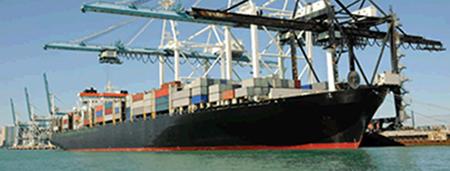 Reducing exposure to diesel exhaust in and around ports is important for public health and the environment.
Reducing exposure to diesel exhaust in and around ports is important for public health and the environment.
While EPA nonroad and on-road mobile source regulations apply to new engines, older diesel engines can remain in operation for 30 years or more. Reducing exposure to diesel exhaust in and around ports is important for public health and the environment.
EPA has a national voluntary ports initiative that focuses on the following.
- Removing barriers to technology development and application
- Emission inventories, tools and metrics
- Developing strategies for community-port engagement
- Creating a bridge to EPA/Federal partners
- Funding for projects to reduce emissions from existing diesel engines - Diesel Emissions Reduction Act (DERA)
EPA also provides information through its Clean Diesel Program on diesel emissions, emission reduction technologies and regulations.
Port authorities as well as owner and/or operators of fleets, terminals, drayage trucks, and locomotives all have a role in reducing diesel emissions at the ports where they work and the nearby communities. Near-port communities have a role to play as well in capacity building through learning about ports and developing a community actions that lead to improved conditions.
What Port Authorities Can Do
One of the major issues port authorities are facing today is promoting economic development while protecting environmental quality. Public ports play an integral role in working with private industry to develop and finance marine terminals and facilities, as well as to manage the port. Whether an "operating port" or a "landlord port," public port authorities are key as sponsors of federal navigation projects that benefit all maritime interests. 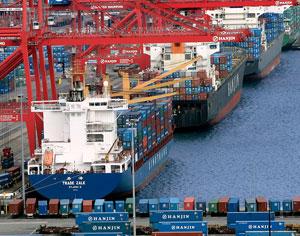 Port authorities are key as sponsors of federal navigation projects that benefit all maritime interests.
Port authorities are key as sponsors of federal navigation projects that benefit all maritime interests.
Learn about near-port community considerations
Orient your port to consider unique environmental justice situations of near-port communities with the goal of working to be a good neighbor for building social equity. Work collaboratively with near-port communities to identify needs and issues related to port activities.
Utilize the Draft Environmental Justice (EJ) Primer for Ports: The Good Neighbor Guide to Building Partnerships and Social Equity with Communities.
Establish anti-idling policies
By establishing an anti-idling policy for trucks, locomotives and cargo handling equipment, diesel emissions can be effectively reduced. Turning off engines when not in use is the smartest and easiest way to reduce air pollution and save money. Not only does unnecessary idling waste fuel, but it causes wear and tear on the engine which requires more maintenance. EPA's SmartWay program maintains a list of verified idling reduction technologies.
Expand off-peak operations hours to avoid congestion
By extending terminal gate hours beyond the regular schedule or offering incentives for off-peak operations, truck queuing, idling, and traffic congestion are shortened. Not only does this increase flow and efficiency, but reduces the impacts of diesel exhaust during ozone hours.
Retrofit with verified technologies, use cleaner fuels and operate more efficiently
Install or require installation of emission reduction devices, replace engines or equipment, use cleaner fuels, and implement operational efficiencies which have been tested and verified. These technologies are cost-effective and yield substantial emission reductions. See EPA’s Clean Diesel Technology pages to learn more about available options. Visit EPA’s Clean Diesel National Grants for information on grants.
Develop an Environmental Management System
Ports across the globe are adopting Environmental Management Systems (EMS) as a way to plan for continuous improvement in environmental performance. For more information, see An Environmental Management System (EMS) Primer for Ports: Advancing Port Sustainability (PDF) .
Develop an emissions inventory
An emissions inventory is necessary for port authorities to understand and quantify the air quality impacts of current port operations. Ports are major contributors of NOx, PM, SOx, and air toxics. Emissions inventories help to assess the impacts of port expansion or increased activity and provide a baseline for developing emission mitigation strategies and track performance over time.
Develop educational programs on air pollution and emissions reductions for terminal operators and fleet owners
One barrier to implementing cost-effective emissions reduction strategies is lack of knowledge on the part of terminal operators and fleet owners about various options. Guidance and education on air quality, air pollutants, technologies and ways to implement emissions reduction strategies not only increase awareness but also increase the opportunities to reduce emissions.
Substitute electric power for diesel power
Using electric shore side power at berth or "cold ironing," rather than running auxiliary diesel engines is effective for ports and vessels that have long hoteling times, multiple annual vessel calls, and high auxiliary power needs, such as cruise ships.
Substitute rail or barge for trucking
Using rail or barge instead trucking increases the volume flow and efficiency of cargo in and out of the port. Rail and barge offer less congestion than trucks and reduces diesel exhaust from unnecessary idling.
Contact state environmental agencies for additional funding opportunities
California’s Carl Moyer Program Exit and Texas’ TERP Program Exit offer grants for activities that reduce diesel emissions. Check to see if your state or local government might offer financial assistance for clean diesel projects.
What Terminal Operators and Fleet Owners Can Do
Terminal operators and managers are the key to a seamless flow of cargo that drives a successful port. Equipment owners and operators have many ways to reduce diesel emissions while maintaining or growing a healthy bottom line.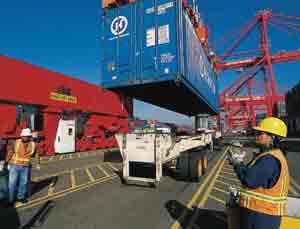 Terminal operators and fleet owners can implement policies that reduce diesel emissions
Terminal operators and fleet owners can implement policies that reduce diesel emissions
Establish anti-idling policies
By establishing an anti-idling policy for trucks, locomotives and cargo handling equipment, diesel emissions can be effectively reduced. Turning off engines when not in use is the smartest and easiest way to reduce air pollution and save money. Not only does unnecessary idling waste fuel, but it causes wear and tear on the engine which requires more maintenance. EPA's SmartWay program maintains a list of verified idling reduction technologies.
Expand off-peak operations hours to avoid congestion
By extending terminal gate hours beyond the regular schedule or offering incentives for off-peak operations, truck queuing, idling, and traffic congestion are shortened. Not only does this increase flow and efficiency, but reduces the impacts of diesel exhaust during ozone hours.
Retrofit with verified technologies, use cleaner fuels and operate more efficiently
Install emission reduction devices, replace engines or equipment, use cleaner fuels, and implement operational efficiencies which have been tested and verified. These technologies are cost-effective and yield substantial emission reductions. See EPA’s Clean Diesel Technology pages to learn more about available options. Visit EPA's Clean Diesel National Grants for information on grants.
What Drayage Truckers Can Do
Drayage truck drivers play an important role in the fabric of port operations, economy and air quality. EPA’s SmartWay Drayage Carriers Program has created a program to help drayage truckers reduce fuel costs and improve air quality.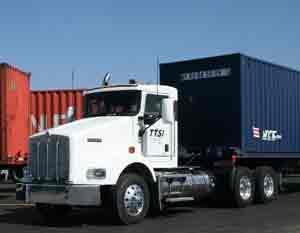 Grants and financial incentives improve air quality at ports
Grants and financial incentives improve air quality at ports
The Port of Los Angeles Clean Truck Program Exit and Port Authorities of New York and New Jersey's Truck Replacement Program Exitexemplify how to use grants and financial incentives to improve air quality.
Replace oldest trucks and engines with newer, cleaner trucks and engines
Newer trucks are subject to stricter EPA regulations and therefore pollute less. Retiring older trucks and engines and replacing them with brand new ones plays a major role in reducing emissions.
Avoid Idling - shut off the engine
Turning off engines when not in use is the smartest and easiest way to reduce air pollution and save money. Not only does unnecessary idling waste fuel, but it causes wear and tear on the engine which requires more maintenance. By establishing an anti-idling policy for trucks, locomotives and cargo handling equipment, diesel emissions can be effectively reduced. EPA's SmartWay program maintains a list of verified idle reduction technologies.
Keep engines well maintained
Engines that are properly maintained and tuned perform better and typically emit less pollution than engines that are not properly maintained. Rebuilding an engine can also significantly lower emissions, enhance performance and provide a cost-effective improvement for high value equipment. Proper maintenance or rebuilding lowers emissions by burning fuel more efficiently and can reduce operation costs and extend engine life.
Retrofit with verified technologies, use cleaner fuels and operate more efficiently
Install emission reduction devices, replace engines or equipment, use cleaner fuels, and implement operational efficiencies which have been tested and verified. These technologies are cost-effective and yield substantial emission reductions. See EPA’s Clean Diesel Technology to learn more about available options.
Operate during off-peak hours
By operating during off-peak hours, truck queuing, idling, and traffic congestion are shortened. Not only does this increase flow and efficiency, but reduces the impacts of diesel exhaust during ozone hours.
What Rail and Locomotives Can Do
Throughout history, rail has served an efficient and reliable role in the movement of freight across the U.S. Some ports are switching from trucks to on-dock rail to improve efficiency and reduce congestion at the port.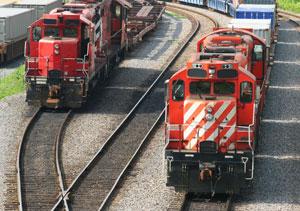 Idle reduction technologies not only reduce emissions but also save fuel.
Idle reduction technologies not only reduce emissions but also save fuel.
Reduce idling for rail switchers
The fuel savings associated with some idle reduction technologies can actually pay for the system and save money in the near and long term. EPA's SmartWay program maintains a list of verified idle reduction technologies.
Retrofit rail yard equipment and switchers
Switcher locomotives often have older, high emitting engines and their terminals are typically located near residential neighborhoods. Due to the nature of their business, these locomotives often operate long hours.
Installation of emission reduction devices or engine replacements which have been tested and verified are cost-effective solutions that yield substantial emission reductions. See EPA’s Clean Diesel Technology pages to learn more about available options.
